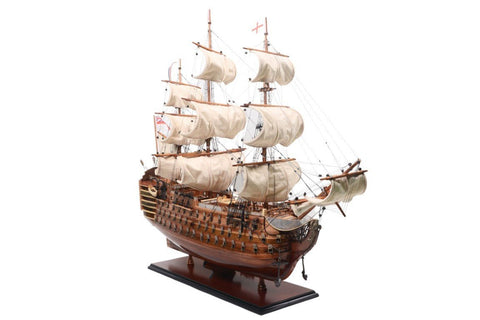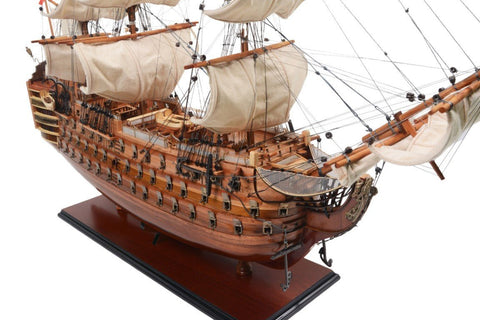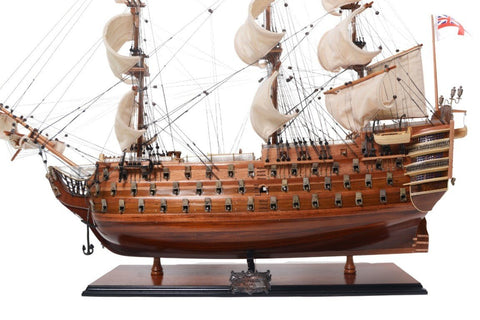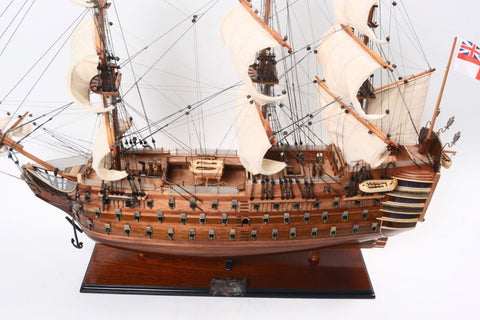





Exclusive model of the sailing ship HMS Victory VIC80R
Išskirtinis burlaivio "HMS Victory" - vieno garsiausių laivų istorijoje - modelis.
Exclusive model of the sailing ship HMS Victory VIC80R Model of the sailing ship HMS Victory - one of the most famous ships in history. A sailing ship of the line of the British Navy built between 1759 and 1765 at the Chatham Dockyard. The name for the ship - Victory - Victory was chosen to commemorate the victories the British army achieved during the Seven Years' War at the Battle of Minden and the Battle of the Plains of Abraham, as well as the naval battles of Lagos and Quiberon Bay. The ship model is fully assembled and ready for presentation. Attention to detail with which it was made will win the hearts of naval and history enthusiasts. HMS Victory ship model will be a beautiful decoration for a living room or study, to which it will bring a nautical and historical character. HMS Victory model - information: - Dimensions: length: 97cm x 29cm x 83cm- Our model is characterized by great attention to detail. It was faithfully reproduced and scaled based on historical plans and drawings.- Handmade mainly from exotic wood, but also from metal and natural materials in a manner similar to the construction of the original ship.- Several hundred hours to produce the model.- Product of artistic craftsmanship.- Painstakingly detailed elements such as sails and rigging, 3 rows of metal cannons on each side, metal steering wheel, lifeboats, metal lamps, rich ornamentation.- Model does not contain any plastic parts. It is fully assembled and ready to be set up.- Model is seated on a wooden base with the name of the ship.- Careful packaging - the model is protected by a wooden cage inserted in a carton. Trafalgar - the most famous naval battle involving HMS Victory - ships of the Franco-Spanish fleet sailed north in line formation. Around noon on October 21, 1805, at the height of Cape Trafalgar, British Admiral Horatio Nelson attacked the enemy with two columns sailing across the enemy formation. Such a battle plan was designed to cut off the strongest ships of the enemy, which was outnumbered, and crack down on the rest. The right column, numbering 15 ships under the command of C. Collingwood on the Royal Sovereign, was to cut off the rearguard, while the left, a 12-ship column under Nelson's command on the Victory, was to cut off the center. While carrying out this maneuver, the French and Spanish kept firing at the approaching British ships, wreaking havoc. Due to the low wind, the British columns sailed slowly, unable to respond with fire for almost an hour. Victory was still under fire At 12:45 Victory cut the enemy line between the ships Bucentaure and Redoutable. As the two fleets approached, small arms fire was exchanged. French gunners from the ship Redoutable were glaring at the English from above the rigging. The commander of the British fleet, distinguished as usual by his attire, was an easy target for them. At 1:15 pm, a French sailor fatally shot him in the spine. The admiral had himself carried below deck so the crew wouldn't see it. He died at 16:30, but the battle was won. Thanks to high morale and the tactics employed, Nelson won his last victory. The Allies lost 22 ships, about 3,250 killed, about 2,500 wounded and about 7,000 taken prisoner. British sailors were killed 449.The battle marked the beginning of the great hegemony of the British in the seas of the world, making a major contribution to the establishment of the British colonial empire. Subsequently, the ship underwent an overhaul.

